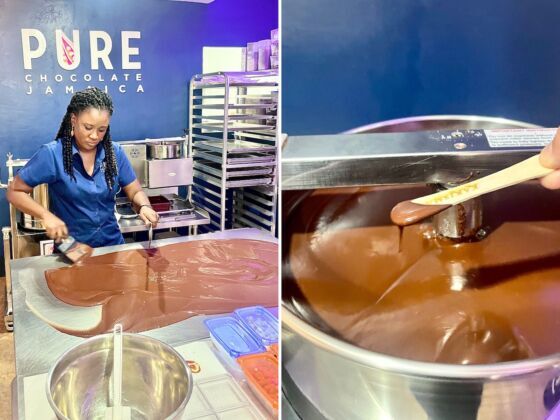As I walked into the artisan chocolate studio at Pure Chocolate Company’s location in Ocho Rios, Jamaica, co-owner Rennae Johnson handed me a cup of chocolate tea. The traditional Jamaican drink is typically made with cocoa, spices like cinnamon, and milk (in this case coconut milk). The warm liquid is thick, rich, and just sweet enough that I don’t get saccharine overload despite quickly finishing the entire cup. Pure Chocolate’s final version is still in the works, but it’s a fitting start to an experience that highlights what local Jamaican chocolate is all about.


You Can Make Your Own True Jamaican Chocolate on the Island at Pure Chocolate Company
@foodwtf Making #chocolate from scratch at 📍Pure Chocolate Company in #OchoRios #Jamaica #foodtiktok #cookingclass #chocolatemaking ♬ Little Things – Adrian Berenguer
Jamaican-born Johnson and her husband Wouter Tjeertes started Pure Chocolate in 2017. Both worked as pastry chefs at a Jamaica resort before becoming partners (in life and business), and Tjeertes spent three decades as a chocolatier and executive pastry chef across Europe and the Caribbean. When they struck out on their own with Pure Chocolate, the primary focus was on doing everything as local as possible.
The company uses local cocoa that can be traced back to a small group of farmers that it buys from directly at above-market prices. Pure Chocolate uses single-origin Criollo and Trinitario beans from the John Crow Mountains, which run adjacent to the Blue Mountains where Jamaica’s famous coffee grows. The beans are fermented and dried by hand on the island, and even the wrappers are tied to Jamaica: the art-driven labels are created by local artists like Taj Francis and Kokab Zohoori-Dossa.
Cacao originally comes from the upper section of South America (cacao refers to raw beans, while cocoa refers to the beans after they’ve been fermented and dried) and people on Jamaica have grown the plant and used cacao beans for hundreds of years — historians found evidence that a drink of hot cocoa, milk, and cinnamon has been made on the island since at least 1494. English colonists exploited the cacao farms after taking the island from the Spanish in the 1700s. Jamaican chocolate never reached the same volume as sugar or garnered as much recognition as the island’s premium coffee and rum. According to Forbes, cocoa production shrank from 2,000 tons per year in 1995 to 200 to 400 tons in 2010.
Interest is slowly coming back, however, and Johnson and Tjeertes say they hope that Pure Chocolate can be one of the catalysts to increase the awareness of the quality of Jamaican chocolate that’s made on the island. By buying direct from the source, the couple can provide a better life for farmers, ensure no child labor is used, and more sustainably source a crop that is highly impacted by climate change.
The investment makes sense: better treatment of farmers leads to better beans, Tjeertes explained. Jamaican artisan chocolate quality in large part comes from the island’s “fine or flavor” cocoa beans as opposed to “bulk” or “ordinary” beans. The International Cacao Council lists that Trinidad & Tobago, Grenada, Dominica, and Saint Lucia grow 100 percent fine or flavor cacao beans, and Jamaica is certified for 95 percent. Fine or flavor cocoa has fruity, floral, and nutty notes and most often come from Criollo or Trinitario varieties.
At the Pure Chocolate location in Ocho Rios, Johnson and Tjeertes mention the farmers they work with by name as I pour chocolate into a mold with a cacao bean pattern. Fermenting and drying takes place in Spanish Town, where Johnson is from. The production of the chocolate liquor, and then that liquor into bars and other treats, happens here next to the grinders that whirred away as I finished topping my bar with dried fruit.
I packaged my chocolate that I made as soon as it cooled in the fridge. It was plenty to take home and share, though it was hard to resist the chocolates made with rum, jerk spices, matcha, and a wide variety of other things that are sold at the storefront.
Pure Chocolate’s two-hour chocolate making workshop can be booked online, and takes place at the Island Village shop in Ocho Rios. Pure Chocolate also offers virtual tasting events and chocolate pairing events with things like rum, wine, and cheese. Aside from the store in Ocho Rios, there are a number of outlets in Jamaica (and a few in the Netherlands) that sell Pure Chocolate products. Regardless of how you get your hands on one of the award-winning bars, the taste of true Jamaican chocolate is one you’re not likely to forget.